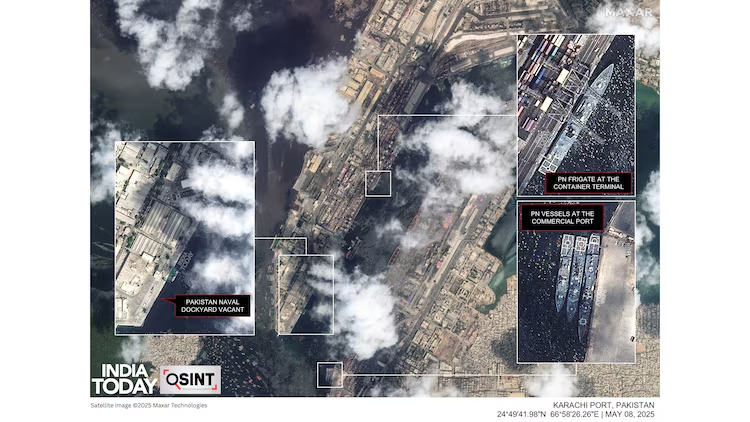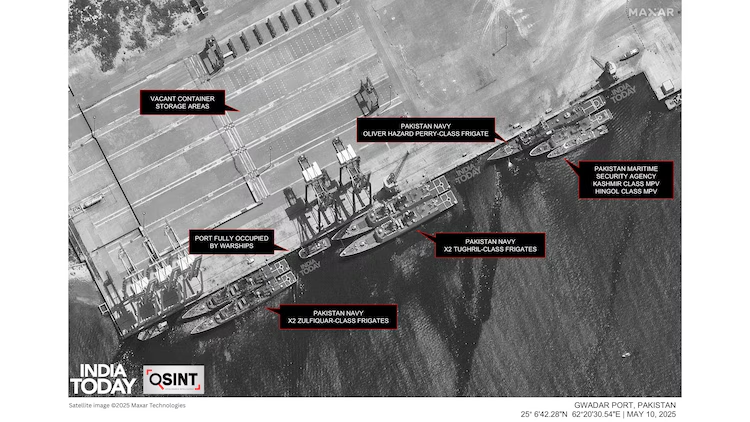Fresh commercial satellite imagery analysed by India Today’s OSINT team has revealed that the Pakistan Navy adopted a defensive posture at the peak of Operation Sindoor in May, moving frontline warships out of Karachi’s naval dockyard to commercial ports and shifting several key vessels westward to Gwadar, barely 100 km from the Iranian border.
The images — captured between May 7 and May 10 — establish how Pakistan’s leadership, despite publicly threatening retaliation after Indian strikes on terror infrastructure, quietly scattered and concealed its naval assets to avoid escalation.
Karachi’s naval dockyard left bare
Satellite pictures from May 8 show Karachi’s naval dockyard unusually empty, while at least four Pakistan Navy (PN) warships were spotted docked at commercial cargo and container terminals, metres away from civilian vessels. Among those identified were PNS Alamgir (an Oliver Hazard Perry-class frigate), a Babur-class corvette, a Damen Offshore Patrol Vessel, and another frigate docked at a container terminal.
Vice Admiral SC Suresh Bangara (Retd), who commanded the daring 1971 naval raid on Karachi, called this posture “a sign of low operational readiness” and said parking warships at civilian berths suggested an attempt to evade missile strikes by hiding among commercial activity.
“Coupled with Pakistan’s use of commercial air traffic to shield its military aircraft, it shows their willingness to risk civilian assets for survival,” he observed.

Gwadar turned into a naval refuge
High-resolution imagery from Maxar Technologies confirms that by May 10, Gwadar — touted as the jewel of the China-Pakistan Economic Corridor but with little ongoing trade — had turned into a temporary naval base.
Two Zulfiquar-class frigates, two Tughril-class frigates, the US-built PNS Alamgir, and two maritime patrol vessels were docked alongside offshore replenishment tankers. The port’s vast container storage area lay empty while its docks teemed with military hardware.
Analysts note that this dispersal highlighted Islamabad’s fear of Indian strikes. “With INS Vikrant undertaking its maiden combat deployment in the Arabian Sea, Pakistan preemptively dispersed its fleet westward,” said geo-intelligence researcher Damien Symon.
Submarine deterrence weakened
The Pakistan Navy’s reliance on Gwadar also reflected the pressure on its submarine arm, with several boats sidelined for refits and maintenance, diluting its undersea deterrence.
Symon said Gwadar was “reconfigured as a fallback base” with its 600-metre berth crowded with warships, offering temporary security but also making the vessels more visible to satellites and potential strikes.

Indian Navy’s readiness
The Indian Navy, meanwhile, maintained a forward deployment in the Arabian Sea. Vice Admiral A.N. Pramod had earlier confirmed that forces were fully prepared to strike Karachi and other key maritime targets if escalation demanded it.
Vice Admiral Bangara emphasised that Operation Sindoor, though paused, had demonstrated the effectiveness of joint planning.
“India executed a classic joint operation. Without firing a single missile from the sea, we achieved our objectives while conserving ordnance for any prolonged conflict,” he said.
The satellite imagery provides definitive evidence that while Pakistan’s leadership talked of retaliation, its Navy largely remained in hiding — a sharp contrast to India’s forward and offensive posture during Operation Sindoor.












